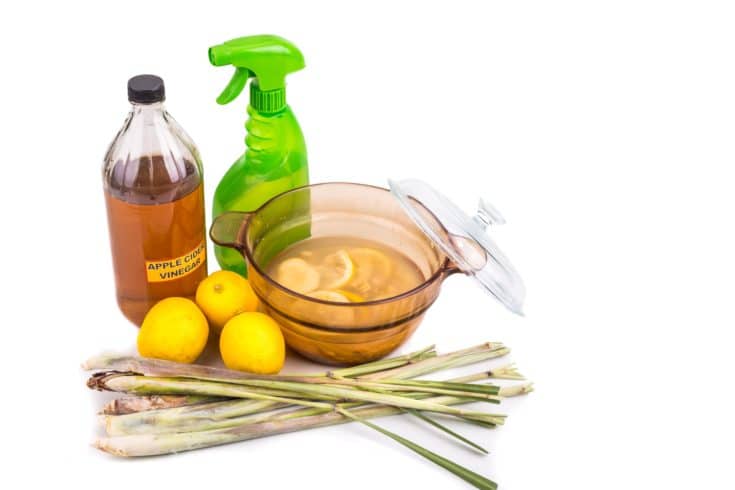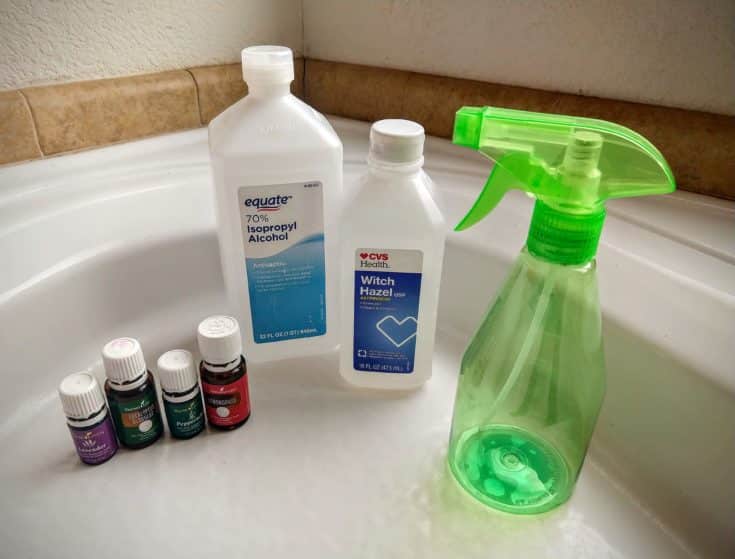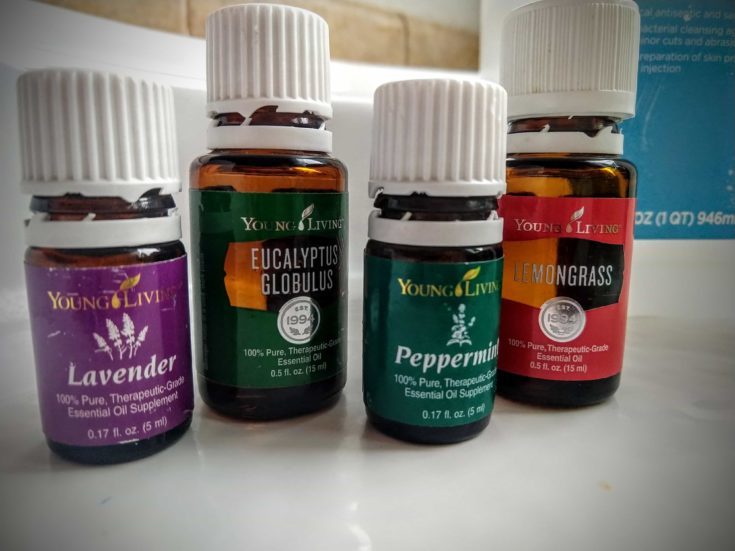When summer rolls around, most people cannot wait to get outside to enjoy the long evenings, social gatherings around the BBQ, and endless opportunities for children to run off their energy. Unfortunately, biting insects can quickly put a damper on these enjoyments and chase you back indoors if you haven’t taken the proper precautions.
Although there are many products you can buy to help deter insects from showing up uninvited to your backyard shenanigans, many include some questionable ingredients, especially for young, delicate skin. Since bugs can carry diseases and often create allergic reactions in those they bite, having a good insect repellent is a must have. This DIY recipe explains how to make an easy bug spray with essential oils that can be very effective when used properly. Read on for a tried and true homemade bug spray option for safe summer use.
Reasons to Use a Bug Repellent

Insects buzzing around your head may be incredibly annoying, but it should be the least of your worries. Mosquitoes and biting gnats (or midges) in particular seem to create the most chaos each summer as their bites are not only itchy and uncomfortable, but they can also cause severe allergic reactions, infections, and even make you susceptible to diseases.
The most common reactions include raised welts and the desire to scratch the area of the bite, with children usually experiencing the worst of the symptoms as their bodies react to the insect saliva that causes a brief allergic reaction. The scratching of these bites can open a wound leaving your body open to dirt and debris when not properly attended to.
Mosquitos are also known to carry vicious diseases. The majority of these are not found on the North American continent, but if know you are in or traveling to areas that have mosquito-borne illnesses, strong repellents are suggested. The most common concerns in North America are West Nile and The Zika Virus. West Nile can cause neurological damage in both humans and certain animals, such as horses. The Zika Virus is believed to be a cause of the birth defect known as microcephaly as well, and it can be transmitted from human to human without the knowledge of infection.
Biting insects do so in order to feed on your blood. The best repellents convince bugs through scent and taste that you are not a choice for a meal. An insect spray or lotion can help deter these bugs and create an environment in which they are not as attracted to either landing on your skin and feeding on your blood. Luckily, there are many natural products that work very well in doing so in areas where concerns about the disease are not as prevalent.
Concerns With Insect Spray Ingredients

Many people look to more natural options because of concerns with certain ingredients used to deter and kill insects that can be found in many repellents. This is especially true for the more delicate, porous skin of children. Although the following ingredients can most definitely be used safely with proper care (or put only on clothes on not skin), they are not always the best to use with kids who are still prone to placing things in their mouth.
Deet, Permethrin, and Pyrethroids are the most common ingredients in over-the-counter repellents. These are used in sprays, lotions, and even clothing in various strengths to help protect you from bites. All have been found to create issues with neurotransmission in high doses, overexposure, or improper use, and none are considered environmentally friendly. Care should always be taken to avoid as much skin contact as possible, and it should never be ingested or inhaled. Following directions of products that contain these ingredients are very important.
If you live in an area where a particular disease is a large concern, you may want to speak with your physician about the best sprays for your child. But for everyday use, more natural ingredients can be very effective and also serve as an addition to stronger options to avoid having to use too much of any one chemical.
Best Essential Oils for Bug Sprays
Luckily, nature provides certain scents that act to keep insects at bay. If you have wondered how to make your own DIY essential oil mosquito repellent, these are some of your best options.
They might not be as long lasting as certain chemicals, but with fastidious and proper use, it can be highly effective. Although care should be taken with their use as well, they are considered much safer for both humans and the environment. There is quite a list of oils that work to repel insects, but the strongest options from which you can choose are as follows:
- Clove has many uses for both skin care and oral health. It has a numbing effect, and its strong, spicy scent is not a favorite of any sort of bugs.
- Lemongrass is commonly used in a variety of application due to its long and varied history in reference to both scent and human health. The light, refreshing lemon scent is a deterrent to insects.
- Rosemary can be planted to help deter insects as well as used in a spray to deter them. The heady herb is favored for both scent and flavor.
- Tea Tree is an amazing astringent and is used as an ingredient for much more than just repelling insects. It also helps keep lice away and works as an antifungal as well.
- Eucalyptus is much more than a way to help open your airways. This plant can be grown and used as a favorite ingredient as the menthol scent and properties are less than inviting to local bugs.
- Cedar is an ancient solution to keeping stored clothing safe from insects and smelling fresh. This woodsy, clean scent is rich and well loved by humans but is a bane to flying and burrowing insects.
- Geranium is used for physical, emotional, and mental health and can aid in focus. The scent is also a deterrent to many insects and mixes well with other oils as a spray or balm.
- Lavender is an amazing all around oil that has a calming effect, but it also promotes blood flow and healing and is found in many skin care regimens. It can be grown, diffused, and worn to keep insects at bay.
- Peppermint is incredibly invasive when allowed to grow unchecked, but it works well to deter all sorts of critters- mice included! It also promotes blood flow, works to aide with congestion and headaches, and mixes well with other scents.
What You Will Need to Make a Bug Spray:

You can most definitely play upon these ingredients to create your own way of application. To make a bug spray you will need the following:
- Approximately 60 drops of your choice of oil or oil blends– Make sure you are using a water soluble oil, not one that has already been mixed with a carrier oil of some sort. You want a pure oil, not just a bottle that says 100% oil because technically a carrier oil IS 100% oil as well. Carrier oils, such as fractionated coconut oil and grapeseed oil can get sticky and clog up your spray bottle.
- ½ cup witch hazel
- 1 cup water (or vinegar)
- 2 tablespoons Isopropyl Alcohol– The alcohol will help create a well-mixed substance. Oil and water do not mix, but with the addition of alcohol some of this oil will break down to create a more blended mixture upon shaking.
- Glass or plastic spray bottle– Glass truly is the better choice for this, but glass spray bottles are often hard to find. You can pick up inexpensive plastic bottles for use, and if they clog, they are easy and cheap to replace.
Step 1: Drop Oils in Bottle and Add Alcohol

Add your oils and alcohol to the bottle first and swish around well to combine. The alcohol helps to break the oils down and makes it easier to truly mix together. Plus, it carries the scent well and evaporates- leaving behind the oils after spraying.
I choose a mixture of eucalyptus, lavender, lemongrass, and peppermint. The resulting smell was somewhat astringent, but not unpleasant by any means.
Step 2: Pour in Witch Hazel
Add the witch hazel and agitate well. This is a natural astringent, mixes better with oils than water, and evaporates more quickly than water for an even application of the spray. Once well shaken, you shouldn’t see the separation of the oils from the rest of the liquid.
Step 3: Add Water and Shake Before Use

In this case, water serves as more of a carrier. You can also use vinegar, but vinegar is often caustic smelling and may sting upon application for sensitive skin. It is not harmful but can be a bit much, especially for children.
If a spray is not your favorite choice, you can easily make another option that is just as effective. The following provides some quick instructions:
What You Will Need to Make a Balm:
- 1/4 cup beeswax pastilles
- 1 cup coconut oil (NOT fractionated)
- 20 drops of your choice of oils
- Jar with a lid
Directions:
Melt your beeswax in a double boiler and gently stir in the coconut oil. Allow to cool slightly, but not so cool it solidifies. Mix in your oils, blending well to ensure it is a good homogenous mixture (meaning it is evenly distributed). Allow to cool. Apply as needed and rub into skin.
What You Will Need to Make a Roller Bottle:
- A 10 ml roller bottle
- 15 drop essential oils of your choice
- Carrier oil to fill the bottle – fractionated coconut oil and grapeseed oil are favorites to use.
Directions:
Mix all ingredients in the bottle starting with essential oils and then add in the carrier. Shake and roll onto exposed skin.
What You Will Need to Make a Lotion:
- 1 cup of your favorite scent free lotion
- 20 drops of your choice of oils
Directions:
Mix oils well into your lotion and apply directly to your exposed skin.
Conclusion
Making your own bug spray is incredibly easy, quick to do, and more than effective against the common biting insects you will find in your backyard. Also, you can always play with the strength of your mixture as well as the scent to find exactly what works best on the area you live in. Sprays can easily translate into balms and lotions, and you can easily travel with your favorite application when hiking and camping for quick use.
If mosquito and insect-borne disease is a concern, you may want to consider stronger chemical additions with carefully followed directions- and always check with a physician concerning its use with a child (especially when chemical ingredients are involved). Let us know if you have questions or comments below. And, as always, please share!
Check out our infographic and don’t forget to share!

The post Tried and True: Homemade Essential Oil Bug Spray appeared first on Better Mind Body Soul.
No comments:
Post a Comment